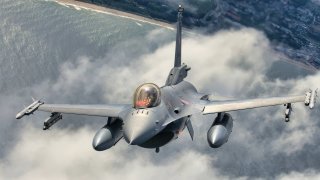A U.S. Air Force F-16 Fighting Falcon Just Crashed
A United States Air Force F-16 Fighting Falcon from the 49th Wing crashed near Holloman Air Force Base in New Mexico, prompting immediate medical attention for the ejected pilot and safety warnings due to potential hazardous chemicals
Summary: A United States Air Force F-16 Fighting Falcon from the 49th Wing crashed near Holloman Air Force Base in New Mexico, prompting immediate medical attention for the ejected pilot and safety warnings due to potential hazardous chemicals
-This incident is part of a series of mishaps involving the F-16, though it remains one of the most prolific and enduring aircraft in military service globally. Despite recent crashes, the F-16's extensive use and ongoing updates underline its operational importance.
-The aircraft's evolution over 50 years has included significant advancements in technology and capabilities, contributing to its continued relevance in modern air combat and training scenarios.
F-16 Fighting Falcon: Safety and Durability in Focus After New Mexico Crash
Flying any combat aircraft comes with risks, a point that was remembered on Tuesday when a United States Air Force F-16 Fighting Falcon crashed west of Holloman Air Force Base (AFB), New Mexico, just outside of White Sands National Park.
The F-16, assigned to the 49th Wing, went down at around 1:50 pm ET (11:50 am local time). The pilot ejected and was transported by ambulance for medical care.
In a statement posted on social media, the Air Force base announced that "all non-emergency personnel should avoid the area to prevent possible exposure to hazardous chemicals onboard the aircraft," and added, "An investigation conducted by a board of qualified officers is underway to determine the cause of the incident. Additional details will be released as they become available."
Certain areas of the park were closed to the public to allow for emergency response.
The New Mexico base is home to the 54th Fighter Group, which is assigned to the 49th Wing of the Air Education and Training Command. The 54th Fighter Group operates an F-16 school, while Holloman is one destination where rated Air Force pilots learn how to fly the F-16 in a 37-week Basic Course, also known as the B-Course.
The Latest F-16 Fighting Falcon to Suffer a Serious Mishap
Tuesday's crash came about three months after an F-16 Fighting Falcon crashed in South Korea at the end of January. It was also the third such crash on the Korean peninsula in just nine months, but all of the pilots of the downed aircraft were able to eject safely.
As noted by Air & Space Forces magazine, the last time a Fighting Falcon crashed in the continental U.S. was on March 23, 2022, when an Oklahoma Air National Guard F-16 went down in Western Louisiana. That pilot was also able to eject safely from the aircraft.
In addition, there have been a total of thirty-three F-16s destroyed in mishaps from 2010 to 2021.
A Rather Safe Aircraft
Though the number of crashes may seem high – with around 670 hull-loss accidents – it still needs to be remembered that the single-engine supersonic multirole F-16 Fighting Falcon is the world's most common fixed-wing aircraft in military service with more than 4,600 produced to date.
In other words, the more aircraft in service, the more likely there are to be crashes.
The F-16 made its maiden flight 50 years ago this past January and it has been steadily updated and improved during its five decades in service.
It has been produced in 138 different configurations from the prototype to its latest production models. Successive changes have seen the addition of improved cockpit technologies, enhanced avionics, sensors, and weapons – while great effort has been made to ensure the fighter is more reliable and easier to maintain and control.

The latest F-16s have an increased range and payload, advanced infrared sensors, and laser targeting devices, while it has improved survivability thanks to more advanced electronic warfare sensors and sophisticated decoys.
The F-16 is also being employed in autonomous aircraft tests and even took part in the first dogfight involving an AI-controlled aircraft against a human operator.
Author Experience and Expertise: Peter Suciu
Peter Suciu is a Michigan-based writer. He has contributed to more than four dozen magazines, newspapers, and websites with over 3,200 published pieces over a twenty-year career in journalism. He regularly writes about military hardware, firearms history, cybersecurity, politics, and international affairs. Peter is also a Contributing Writer for Forbes and Clearance Jobs. You can follow him on Twitter: @PeterSuciu. You can email the author: [email protected].
Image Credit: Shutterstock.


